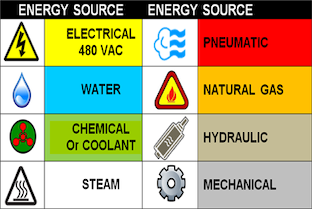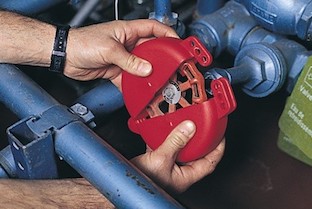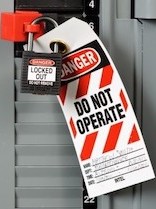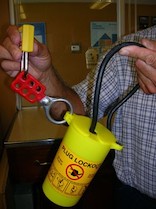Modern machinery can contain many hazards to workers from electrical, mechanical, pneumatic or hydraulic energy sources. Disconnecting or making the equipment safe to work on involves the removal of all energy sources and is known as isolation.
Lock-out/Tag-out refers to the safety procedure used in industry and research settings to ensure that dangerous machines have been properly shut-down and are incapable of being started up again prior to the completion of maintenance or servicing work. It requires that all hazardous energy sources have been (1) identified (2) isolated and (3) rendered inoperative to prevent the release of potentially hazardous energy prior to the start of any repair or maintenance procedure. This is accomplished through the locking and tagging of all energy sources. Some common forms of energy isolation include electrical circuit breakers, disconnect switches, ball or gate valves, blind flanges, and blocks. Push buttons, e-stops, selector switches and control panels are not considered proper points for energy isolation.




Lock-out consists of placing a disconnect switch, breaker, valve, spring, pneumatic assembly, or other energy-isolating mechanism in the off or safe position. A device is placed over, around, or through the energy-isolating mechanism to lock it in the off or safe position, and only the person attaching it applies a removable lock to the apparatus.
Tag-out is the process by which an energy-isolating device used for lockout is placed in the off or safe position and a written warning is attached to the device or placed in the area immediately adjacent to the device. The tag must identify the person who applied it and be durable and able to withstand the environment in which it is placed. The tag must be substantial so that it can be attached to a variety of locations and will not come off. A tagout device will be used only when the energy-isolating device is not capable of being locked out. The required means of attachment for a tagout device is a self-locking, non-reusable, nylon cable-type tie that is capable of withstanding a 50-lb. force.
Lock-out/Tag-out Devices such as key or combination locks are used to hold the energy isolation device in a safe position for the duration of the job. Locks are required to be standardized in color, shape or size. The industry best practice for lock-out/tag-out is all red locks and devices; however, in some facilities, the use of different colored locks may be beneficial for distinguishing between trades. Furthermore, locks must be substantial enough to prevent removal without the use of excessive force and tags must be substantial enough to prevent inadvertent or accidental removal (generally affixed with an all-weather nylon cable tie). These locks and tags must also clearly identify the employee applying and using the device. Tag-out devices, which include a prominent warning tag and means of attachment, are also required to be used in conjunction with lockout devices.
The UC Santa Barbara Energy Isolation - Lock-out/Tag-out (EI-LOTO) Program requires campus, field station personnel and contractors to implement safe procedures when working on UCSB equipment or utility systems with one or more energy sources. Because of the potential for injury from energy sources that operate equipment / utility systems, this program guides safe installation, set-up, adjustment and maintenance work on equipment by isolating energy sources prior to commencing work. The program is required by Cal/OSHA safety regulations.
This EI-LOTO Program is applied to ALL forms of potentially hazardous energy and is applied to every individual piece of equipment that has potentially hazardous energy. The types of energy needing to be isolated include the potential energy (mechanical springs in tension or compression, compressed gas cylinders, counter weights, etc.), kinetic energy (rotating flywheel, moving parts, rolling components, parked vehicles, etc.) and utility energy (electricity, compressed air, steam, domestic water, etc.) that may be part of a particular machine or utility system. Such equipment may include building mechanical systems such as HVAC and air handlers, some larger experimental equipment that is hard wired or plumbed to building utility systems such as a Scanning Electron Microscope, an air compressor, a printing press, some shop equipment such as a programmable milling machine, CNC equipment, wood-working equipment, powered cranes and other lift equipment, etc. It may even apply to equipment that can be ‘unplugged’ but may have energy potentially stored in the ‘unplugged’ equipment.
This program is applied prior to working on all types of equipment powered by one or more energy sources, or whenever an equipment guard is removed or safety interlock is bypassed, or whenever a person must place any part of their body into potentially-operating equipment.
This program does NOT apply to:
- Minor tool changes, adjustments, and other small service activities that take place during normal operations if they are routine, repetitive, and integral to the use of the equipment. (Example: Changing a drill bit on a drill press.)
- Equipment that is isolated and made safe by simply unplugging an electrical cord, compressed air hose, or some other single-source energy supply when the person working on the equipment has exclusive control over the connection to the energy source.
“Live Work” or “Hot Work” on equipment that cannot be shut down and locked-out / tagged-out is allowed by the program provided that:
- Department management demonstrates that continuity of service is essential, and
- Shutdown of the system is impractical, and
- Special equipment is provided along with specific standard operating procedures that are documented and followed that will provide effective protection for personnel. (Example: Work on certain life-sustaining equipment or utility lines.)
All three of the above criteria must be met before “Hot Work” is permitted by law. If they cannot be met, then EI-LOTO must be practiced. If the above criterion can be demonstrated by management, prior to conducting “Hot Work” contact EH&S Safety Engineering to review safe work procedures in order to assist in developing adequate safeguards and “Hot Work” processes.
Roles and Responsibilities
Owner Departments are responsible for identifying equipment that has single or multiple sources of energy for operation that fall under the energy isolation requirements of this program. Academic Departments that own / operate research and other equipment in existing buildings not under control of a “Facilities Maintenance” department must apply the EI-LOTO Program to their equipment. Every “Owner Department” must survey and is recommended to inventory all equipment owned by the Department that requires an equipment-specific EI-LOTO Procedure be developed. Attachment 1 of the EI/LOTO written program is a template an Owner Department may use to survey and inventory equipment requiring an equipment-specific EI-LOTO Procedure, and track Cal/OSHA-required annual audits of those procedures.
Departments must create, and provide for employee and contractor use, written EI-LOTO procedures for individual “location specific” pieces of equipment. Attachment 2 of the EI/LOTO written program is a template used to develop individual EI-LOTO procedures for specific pieces of equipment.
Owner Departments must identify individuals who are “Qualified” to conduct energy isolation through a documented “Qualification” process. This process is documented using Attachment 3 of the EI/LOTO written program. All “Qualified” persons must have documented training on this EI-LOTO Program. Departments may arrange with EH&S/Industrial Safety staff for personnel to receive documented training or may use another vendor for “Qualifying” personnel as long as the contents of this EI-LOTO Program are included in the training curriculum.
The Principle Investigator / Project Supervisor / “Supervisor” must, or may delegate in writing a “Qualified Person” to:
- Inform all faculty, staff, students, work personnel and/or hired-in Contractors working in the area, collectively known as “Affected Persons”, of the existence of this program and its impact on their work area.
- Ensure that their subordinates have had documented training concerning EI-LOTO at a level appropriate to the anticipated level of exposure to hazardous energy sources in their research / workplace.
- Ensure that proper labeling is applied to all disconnect locations on specific equipment controlled by the department. Labeling activities may be conducted by the PI, Supervisor or Qualified Person, another department member under the leadership of this person, or by an outside contractor.
- Determine safe energy isolation procedures specific to equipment to be worked on.
- Conduct an annual audit of equipment-specific energy isolation procedures to ensure they are still accurate and appropriate to needed safe work practices.
- Determine who is a “Qualified Person” that may work on the equipment.
- Inform all “Qualified Person(s)” and / or the Contractor of any known energy sources on the equipment, any energy isolation procedure previously developed for the equipment, and any other known hazards associated with the equipment.
- Conduct meetings that include review of energy isolation procedures for the equipment with all “Qualified Person(s)” prior to commencing work and at the beginning of each work shift.
- Ensure the arriving shift supervisor is oriented by the departing shift supervisor as to the job status along with the arriving shift work crew prior to the arriving shift commencement of work.
- Ensure the departing shift’s supervisor oversees that the arriving shift workers have put locks and tags on all energy sources before the earlier shift’s locks and tags are removed when multiple shifts work on the same equipment.
- Contact EH&S/Industrial Safety staff for assistance in developing energy isolation procedures and providing training to subordinates and “Qualified Personnel” as needed.
For departments hiring Contractors to conduct work at UCSB, the Project Supervisor must be familiar with the Contractor / Joint Projects Roles / Responsibilities. The Project Supervisor representing the department who owns the equipment is responsible for ensuring the Contractor has an EI-LOTO program and follows it. However, the Supervisor is not responsible for evaluating the Contractor’s EI-LOTO program. The Supervisor must make any previously developed EI-LOTO Procedure for the equipment available to the Contractor prior to start of work.
The Supervisor may also make this EI-LOTO program available to the Contractor for their information and use. The Project Supervisor may provide copies of Attachment 2 of the EI/LOTO written program to the Contractor to develop equipment-specific EI-LOTO procedures for that equipment as part of project activities and documentation of safe-work protocols. Any equipment-specific EI-LOTO procedures developed by the Contractor / Project Supervisor must be delivered to the Owner Department as part of the completed project documentation.
All Faculty, Staff and any “Affected Person” are made aware through the EH&S website that “No person ever touches or tries to actuate an energy source that has been ‘locked’ and/or ‘tagged’ in the ‘off’ position by someone else. And, never disturb a mechanical block that has been placed to prevent equipment movement by someone else.”
Faculty and staff who work on equipment affected by this program must be “qualified” to do so by their Supervisor and follow the energy isolation procedures outlined by this program. They must be trained on, and remain current to, its requirements and application through documented training. A “Qualified Person” may develop written equipment-specific energy isolation procedures by completing ‘Attachment 2’ located in the EI/LOTO written program.
For new construction, building retrofits and equipment installed by Capital Projects, the Project Manager ensures requirements of this program are integrated into project documentation; that energy isolation surveys of all affected building systems are completed and provided to the host department; and that signage and labels are installed on energy disconnects in compliance with this program. Requirements are detailed under “Procedures – Administrative Requirements – Equipment Survey – New Facilities and Equipment” of the EI/LOTO written program.
The Contractor follows their own EI-LOTO program when working on University property / equipment. The Contractor provides evidence of their EI-LOTO program to the University Project Supervisor / Manager upon request. The Contractor provides their own energy isolation equipment including locks, tags and hasps. The Contractor follows “Joint Project” requirements as outlined below.
If the Owner Department has previously developed equipment-specific EI-LOTO procedures for equipment the Contractor is working on, the Contractor follows the Department’s procedure. For equipment that has not previously had an EI-LOTO procedure developed, the Contractor surveys the equipment and develops a written EI-LOTO Procedure for it using Attachment 2 of this program. A copy of the Contractor’s equipment-specific EI-LOTO procedure is provided to the Project Supervisor and EH&S Safety Engineering as part of completed-project documentation. As Contractor work progresses, the Contractor informs the Project Supervisor immediately of any newly discovered energy sources or potential hazards associated with the equipment.
For Joint Projects where employees of the University and Contractor(s) are working on the same equipment at the same time, the Project Supervisor, whether employed by the Contractor or University, must hold joint meetings with all personnel in attendance who will be working on the equipment to promote understanding of safe work practices, and open lines of communication between work crews.
EH&S/Industrial Safety staff is responsible for:
- Writing and maintaining this program to meet or exceed Cal/OSHA requirements,
- Informing departments of this program’s requirements,
- Providing general program awareness information across campus,
- Providing assistance for departments and personnel in implementation of this program,
- Providing training on program implementation and requirements to all affected personnel identified by each department,
- Providing an easy method for creation of equipment-specific EI-LOTO Procedures,
- Recommending energy isolation equipment and processes for general and / or specific use,
- Providing assistance in development of EI-LOTO Procedures,
- Providing safety engineering assistance to develop alternative safe-work procedures when “Hot Work” must be conducted instead of EI-LOTO, and
- Updating this program periodically or as regulatory change may dictate.
For further information please contact the EH&S Industrial Safety Program at ehs-industrialsafety@ucsb.edu.